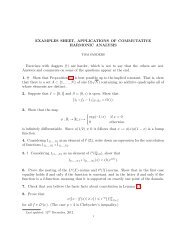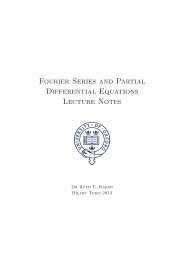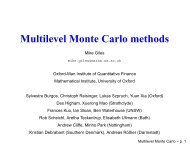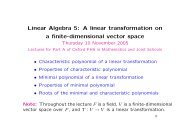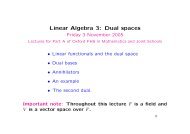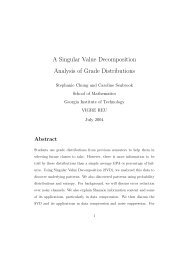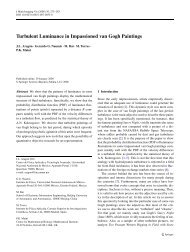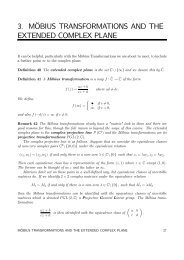Construction of Hyperkähler Metrics for Complex Adjoint Orbits
Construction of Hyperkähler Metrics for Complex Adjoint Orbits
Construction of Hyperkähler Metrics for Complex Adjoint Orbits
You also want an ePaper? Increase the reach of your titles
YUMPU automatically turns print PDFs into web optimized ePapers that Google loves.
3.4 The Kähler Potential <strong>for</strong> Integral <strong>Orbits</strong> 46<br />
We also recall from [Don92] how one may identify Kronheimer’s moduli<br />
space M(ξ) with a submanifold <strong>of</strong> X , when ξ is an integral element <strong>of</strong> t in the<br />
sense that exp(ξ) = 1. This correspondence is given as follows. If (T1, T2, T3)<br />
is a solution to Nahm’s equations defined over the half-line (−∞, 0] and such<br />
that as s → −∞<br />
T1 → 0, T2 → 0, T3 → −Ad(g0)(ξ) <strong>for</strong> g0 ∈ G,<br />
then we construct a rotation-invariant solution to Hitchin’s equations over<br />
the disc, by<br />
Ar = 0,<br />
Aθ = T3(log r),<br />
Φ = (T1 + iT2)(log r)z −1 dz. (3.37)<br />
Donaldson observes that the apparent singularity at 0 is removable in this<br />
integral case. Furthermore, the circle action on X induced by rotations <strong>of</strong><br />
the disc preserves the hyperkähler structure <strong>of</strong> X , so that M(ξ) inherits a<br />
hyperkähler metric, which is in fact the same as Kronheimer’s metric.<br />
Finally, recall that one has another circle action on X defined by<br />
(A, Φ) ↦→ (A, e iθ Φ). (3.38)<br />
It preserves the metric g as well as the complex structure I. It does not<br />
preserve J and K, but acts on ω2 + iω3 as e iθ (ω2 + iω3).<br />
As the circle action (3.38) above preserves the Kähler <strong>for</strong>m ω1, we consider<br />
the associated moment map µ : X → i R. It is computed as<br />
µ(A, Φ) = − 1<br />
<br />
Φ 2L<br />
2= −1 Tr(ΦΦ<br />
2 2<br />
∗ );<br />
see [Hit87a]. Writing Φ = ψ dz, Φ ∗ = ψ ∗ dz, where ψ : D → g c , we may<br />
rewrite µ as<br />
− 1<br />
<br />
Tr(ψψ<br />
2 D<br />
∗ <br />
) dz ∧ dz = −i Tr(ψψ<br />
D<br />
∗ ) dx dy.<br />
D




